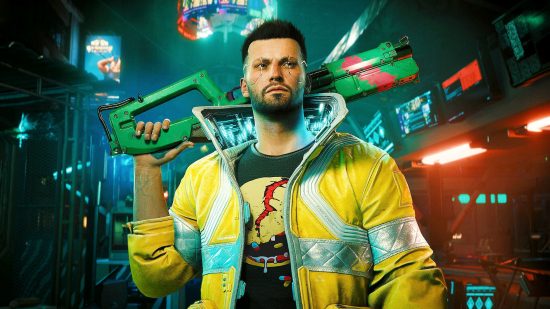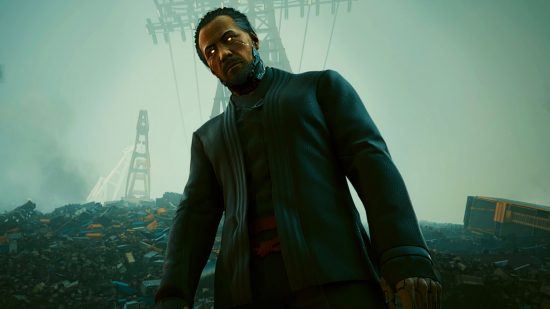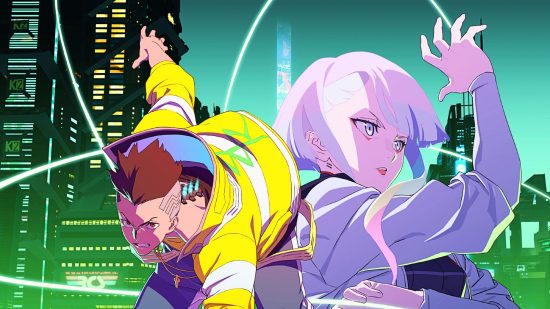The first game I booted up after returning from a recent hospitalisation was Cyberpunk 2077. I am no stranger to near-death experiences; they’re practically a rite of passage for many rare disease patients. A simple infection can turn deadly, triggering another battle for your life. But every round you survive comes with fresh traumas – they’re pretty much two sides of the same coin. So, despite Cyberpunk 2077’s mechanics being physically taxing for me, I reached for the comfort of CD Projekt Red’s portrayal of disability on my return from the hospital, like longing for a friend who understands what you’re feeling without needing you to say a word.
Outside of an op-ed by the Washington Post’s reporter Gene Park, who wrote about the impact Cyberpunk 2077 had on his battle against cancer, I haven’t seen many others mention that V is one of the rare disabled protagonists in gaming. The fact is perhaps obscured by the presence of Keanu Reeves as rockerboy Johnny Silverhand’s consciousness, but it’s always there, literally at the back of V’s head. As the chip works to eventually supplant V’s mind with Johnny’s, V experiences haemorrhages, seizures, and a gradual loss of senses – V even has a prescription to manage them and Johnny’s intrusive voice.
Similar to the biochip, my rare disease, spinal muscular atrophy (SMA), is the result of damaged code. Left untreated, I progressively lose control of my voluntary muscles and gain medical complications. I already live with severe scoliosis and chronic pain dulled with medication. But living with my disability isn’t as hard as articulating the complexities of my experience: emotionally, socially, and economically. Cyberpunk 2077, for all its faults, gave me the language I needed.
I’ve never been shaken – really shaken – by a scene in an RPG, but it finally happened in Cyberpunk 2077, in some oilfield on the outskirts of Night City, where Johnny’s body was discarded 54 years before the game’s events. During this quiet moment, Johnny and V reflect on life, death, trauma, regrets, survival, and second chances like two comrades who have been through hell, and I can’t help but reflect on my life with SMA while this scene plays out. When Johnny tells V that he “never thought we’d make it this far,” I nod in agreement. V’s disability, personified in Johnny, also momentarily personifies SMA – not for me, but for others who might not realise that beautiful memories can be made in a wheelchair under starless skies.

While V’s story displays the emotional complexity of living with a disability, it’s held back from displaying social and economic complexities by the expectations of a triple-A RPG that keep V safe from socioeconomic anxiety. Thankfully, five days after its release on September 13, I was discharged from my hospital stay and came home only to discover that David Martinez’s arc in Cyberpunk 2077’s companion Netflix anime, Cyberpunk: Edgerunners, achieves both. Oh, and just as an FYI, there are some Edgerunners plot spoilers ahead.
Like V, David is nondisabled when we meet him, and it’s the promise of becoming a legend that lures him to his doom. But he finds himself drowning in debts owed to rent and school fees after his mother dies in an accident, leaving only her jacket and a cybernetic implant that speeds up the user’s reflexes. Out of options, he starts using implants to steal money, and after being introduced to the dream of legendhood by a group of mercenaries, he begins the process of transforming himself from a skinny 17-year-old to a muscular half-cyborg. He does this because he believes it’s necessary to climb Night City’s food chain, but it’s cybernetic technology that leads to a prescription for psychosis and, eventually, his death.
It’s a reflection of our capitalist society and the belief that the only way to have a good life is to work harder, faster, and out-produce, regardless of how much harm that causes us. Night City is the perfect antagonist in Edgerunners. Status equals cash, cash equals security, security is threatened by empathy, and profit is placed over the welfare of people every time.
Paramedics in real life don’t try to strip uninsured patients of cybernetics like the ones tending to David do in Edgerunner’s second episode, but healthcare companies and systems do try to bleed us dry. For example: as with other rare disease patients who require orphan drugs, SMA patients like myself can’t afford the new treatments that stabilise the disease’s progression. The cheapest daily oral drug, Risdiplam, costs $340,000 a year.
Yet there are hopeful lessons in CD Projekt Red’s Cyberpunk offerings and the broader revival of interest in the cyberpunk genre. Think of the genre’s aesthetics – a world that accepts body augmentation is a world where no one bats an eye at prosthetics and procedures like tracheostomies, and there is much to learn from that. And David’s and V’s tragic tales are a refocusing of disability representation in games media, from more traditional medical frameworks to systemic ones.
CD Projekt Red’s representations of disability aren’t faultless. We can’t forget Cyberpunk 2077’s troubled development caused developers to crunch, a labour practice that disables employees, nor the publisher’s failure to consider whether the game’s braindance sequences could cause epileptic seizures. But the recent Cyberpunk 2077 player count resurgence and a planned sequel are any indications, they’ve won a second chance to do better – take it from someone who’s had a multitude.


